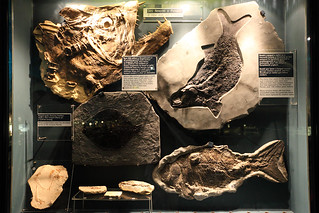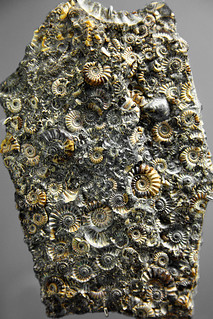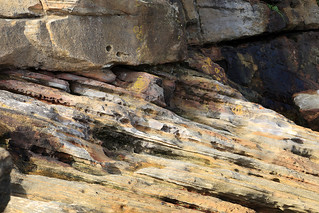

| Archive Blog Cast Forum RSS Books! Poll Results About Search Fan Art Podcast More Stuff Random |
|
Classic comic reruns every day
|
1 {photo of the Grand Canyon}
1 Caption: Deep Time
|
First (1) | Previous (3272) | Next (3274) || Latest Rerun (2895) |
Latest New (5380) First 5 | Previous 5 | Next 5 | Latest 5 Annotations theme: First | Previous | Next | Latest || First 5 | Previous 5 | Next 5 | Latest 5 This strip's permanent URL: http://www.irregularwebcomic.net/3273.html
Annotations off: turn on
Annotations on: turn off
|
 Fossils that look like fish. |
It seems clear from examining a few fossils that they look like some sort of animals or plants, or at least pieces of them. But just as obviously they are made of rock, which no animal or plant is. The connection may seem like a no-brainer to us now, but for a very long time people had no idea what to make of these objects. Some people thought they were bits of animals and plants somehow turned to stone (possibly by alchemy or magic or the whims of the gods). Others thought they were natural patterns that grew in stone that just resembled living things.
The existence of fossils in fact contributed to an erroneous early idea that postulated that rocks grew into different forms and shapes, changing from one to another in a sort of family tree with descendants and ancestors and cousins and so on. The first stage in understanding something is usually to collect as many examples as you can and try to classify them into groups and work out the relationships, if any, between them. The early mistake was to imagine more detailed relationships between various types of rocks than actually exist.
 Fossils that look like shells of animals that do not exist. |
Not so with rocks. A piece of granite and a piece of limestone do not really have any ancestor rocks at all, at least not in the way we think of evolving species. Granite is formed when magma cools and solidifies deep underground. Limestone is formed on the bottom of a body of water as layers of dead seashells[2] get compressed and solidify over time.
Now it is true that some rocks change forms and turn into other rocks. If limestone becomes more deeply buried and is subject to enough heat and pressure underground, it eventually turns into the rock we know as marble. So marble and limestone are related to one another, but neither is related to granite. The set of all types of rocks is splintered into thousands of separate groups, each group containing just one type of rock or a few rocks that are related to one another. There is no all-encompassing hierarchical structure like the tree of biological evolution.
Given this fact, the attempts to impose a hierarchical structure on rocks were doomed to failure. The appearance of fossils that had the same shapes but were found in different types of rock material complicated things further. Were two rocks related if they held similar looking fossils, but otherwise seemed different?
The other confounding fact that stopped people from understanding fossils was that many of them, although they looked like animals, didn't look like any animals that anyone was familiar with. There were fossils that very clearly looked like some sort of seashell, only no real seashell looked quite like it. There were fossils that looked like some sort of cross between a giant cockroach and a crab, only no such creature existed as far as anyone knew. There were fossils that looked like bones, only they were much bigger than the bones of any animal.
 Fossils that look like bones of animals bigger than anything known to exist in the 17th century. |
But how could stones then come to resemble animals? There were actually two different schools of thought on this. The Aristotelian philosophy, descended from the teachings of Aristotle, stated that the "seeds" (i.e. sperm) of living creatures spilt on the ground could enter the earth and grow into animal shapes within the rocks. On the other hand, the Neoplatonic philosophy, from Aristotle's teacher Plato, said that there were fundamental correspondences between parts of the natural world so that disparate objects would naturally grow to resemble one another. So there was no shortage of ideas for how fossils could form in rocks without being living creatures turned into stone.
The tide turned in the 18th century as natural philosophers wrestled with these ideas and the evidence in the fossils and rocks. There were patterns and layers in rock beds around the world that implied various stages in their creation. Abraham Gottlob Werner was a German mine inspector and studied the layers of rocks seen in mines. He classified rocks in a new way: according to the layers of the Earth in which they were found. This convinced him that the layers represented a sequence of deposition, with older rocks at the bottom and newer ones laid down on top. This layering was, in Werner's hypothesis, caused by a major global flood (in line with Biblical teaching), which deposited different sediments as the waters rose, then receded. This event captured fossil creatures in the layers of limestone and similar rocks, laid on top of the older, harder rocks like granites and basalts. Werner's idea became known as Neptunism, after the Roman god of the oceans.
 James Hutton. Public domain image from Wikimedia Commons. |
These ideas were in the offing when James Hutton, a Scottish physician, inherited several farming properties from his father. Hutton moved to the farms and began work improving them. This exposed him to the geology of the region and Hutton became interested in rock formations. He went on several field trips through the Scottish highlands to observe the rocks. One thing in particular struck him: the odd appearance of layers of rock in which the lower layers were tilted at various angles with respect to the flatter layers above. Such unconformities were well known by now, and argued to support the Neptunist hypothesis, which assumed the lower layers were primordial pre-flood rocks.
Hutton observed several unconformities and realised that the lower layers were just like the sedimentary rock layers above, only tilted. He surmised that they must have been laid down as sediments, turned to rock, then tilted, then worn away smooth, and then had new layers of sediment deposited on top to form the remaining layers. What's more, since such formation now occurred in highlands, there must have been some other process which raised rocks up out of the oceans, exposing them to the weather so they could be worn away and made visible. This implied a further cycle of change, as the lower layers had to be tilted and raised, then lowered again to accumulate more sediment, then raised again to be exposed.
Hutton began to realise that all of this could only take place if there was enough time. How much time? Hutton took his cue from what he saw around him. Rocks did not form quickly, nor did they move quickly - these processes were almost invisible to human lifetimes. A staggering realisation began to form in Hutton's mind. The evidence of the rocks suggested that the Earth was old. Not just a few thousand years old as suggested by a literal reading of the Bible and widely accepted, but really, really, really old. Perhaps millions of years old.
 Rock formation at Siccar Point, showing vertical rock layers underneath horizontal layers. Creative Commons Attribution-Share Alike image by Dave Souza from Wikimedia Commons. |
Hutton published his Theory of the Earth; or an Investigation of the Laws observable in the Composition, Dissolution, and Restoration of Land upon the Globe in 1788. He presented his evidence and arguments, and concluded with one of the most thrilling statements ever written in a scientific publication: "The result, therefore, of our present enquiry is, that we find no vestige of a beginning,—no prospect of an end." Hutton had opened our eyes from a cloistered and provincial view of time as something that only mattered to humans to something much greater. Humans could deal with a few thousand years of history, but the idea of millions of years was an astonishing collective shock.
There was resistance. The French zoologist Georges Cuvier led the opposition. In 1796 he concluded from a study of elephants and mammoth fossils that there must indeed have been species that had become extinct. In fact, most of the fossils found around the world seemed to represent extinct species. (The question of whether fossils were natural growths in stone had been settled in favour of them being real animal remnants by now.) In this he was correct, but Cuvier interpreted this evidence to support the hypothesis of catastrophism, which directly opposed Hutton's conclusions. Catastrophism stated that the Earth's history was relatively short, and that rock formation and the extinction of species were caused by sudden and violent disasters such as widespread floods and massive volcanic upheavals.
 Charles Lyell. Public domain image from Wikimedia Commons. |
But Hutton also had influential supporters. Chief among them was Charles Lyell. Also from Scotland, Lyell similarly cut his geological teeth on the distinctive rock formations of the Scottish landscape. Lyell took Hutton's principle of uniformitarianism to heart and expounded on how it affected all of the conclusions of geology. He released his Principles of Geology in three volumes beginning in 1830, putting forward numerous argument supported by geological evidence from his wide travels throughout Europe. Lyell effectively built the case that the Earth must be very old indeed. The idea of deep time had come of age.
Just as the displacement of the Earth being regarded as the centre of the universe, to being a mere planet orbiting the sun had revised our understanding of space, Hutton and Lyell revised our understanding of time. Time wasn't built around humans; it was much bigger and grander than we ever imagined.
In 1831 Lyell suggested to Robert FitzRoy, who was about to leave on a world survey voyage on the HMS Beagle, that he search for particular geologic features. FitzRoy had employed a young naturalist named Charles Darwin to look after scientific duties on board, and gave him a copy of the first volume of Lyell's Principles of Geology. The young Darwin absorbed the book and made observations of islands and coral atolls which affirmed Lyell's theories. It also put Darwin in the frame of mind that there were many millions of years of Earth's history. It was a long, long, deep history of time in which many things that would require a long time might have the chance to occur.
 Sandstone unconformity, Sydney Harbour. |
[1] Or from one of those shops that specialises in selling stones and minerals. Oddly, these shops tend to be New Agey and associate all sorts of mystical powers to the items they are selling. It's an interesting observation on the human psyche and the place of science in our society that the most available place to buy interesting and important geological samples is where they are dressed up in the trappings of mysticism.
[2] "Seashells" is used here as a broad term to include seashells as we normally think of them (i.e. the shells of molluscs), as well as the skeletons of corals, the shells of the tiny floating protists known as foraminifera, and some other types of marine shells.
|
LEGO® is a registered trademark of the LEGO Group of companies,
which does not sponsor, authorise, or endorse this site. This material is presented in accordance with the LEGO® Fair Play Guidelines. |